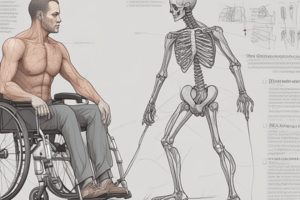Podcast
Questions and Answers
The spinal cord is encased in and protected by the:
The spinal cord is encased in and protected by the:
- Intervertebral disc
- Vertebral body
- Vertebral arch
- Spinal canal (correct)
Once a cervical collar has been applied to a patient with a possible spinal injury, it should not be removed unless:
Once a cervical collar has been applied to a patient with a possible spinal injury, it should not be removed unless:
- Sensory and motor functions remain intact
- The patient adamantly denies neck pain
- It causes a problem managing the ABCs (correct)
- Lateral immobilization has been applied
When immobilizing a seated patient with a short backboard or vest-style immobilization device, you should apply a cervical collar:
When immobilizing a seated patient with a short backboard or vest-style immobilization device, you should apply a cervical collar:
- Before manually stabilizing the patient's head
- After the torso has been adequately secured
- After moving the patient to a long backboard
- After assessing distal neurovascular functions (correct)
A short backboard or vest-style immobilization device is indicated for patients who:
A short backboard or vest-style immobilization device is indicated for patients who:
The _________ is the best-protected part of the CNS and controls the functions of the cardiac and respiratory systems.
The _________ is the best-protected part of the CNS and controls the functions of the cardiac and respiratory systems.
An epidural hematoma is MOST accurately defined as:
An epidural hematoma is MOST accurately defined as:
Rapid deceleration of the head, such as when it impacts the windshield, causes:
Rapid deceleration of the head, such as when it impacts the windshield, causes:
When assessing a patient with a head injury, you note the presence of thin, bloody fluid draining from his right ear. This indicates:
When assessing a patient with a head injury, you note the presence of thin, bloody fluid draining from his right ear. This indicates:
The central nervous system (CNS) is composed of the:
The central nervous system (CNS) is composed of the:
When controlling bleeding from a scalp laceration with a suspected underlying skull fracture, you should:
When controlling bleeding from a scalp laceration with a suspected underlying skull fracture, you should:
When the parasympathetic nervous system is activated:
When the parasympathetic nervous system is activated:
Which of the following sets of vital signs depicts Cushing's triad?
Which of the following sets of vital signs depicts Cushing's triad?
The effectiveness of positive-pressure ventilations when treating a head-injured patient can ONLY be determined...
The effectiveness of positive-pressure ventilations when treating a head-injured patient can ONLY be determined...
Flashcards are hidden until you start studying
Study Notes
Spinal Cord and Protection
- The spinal cord is protected by the spinal canal.
- A cervical collar should only be removed if it hinders airway management (ABCs).
Patient Immobilization
- Apply a cervical collar after assessing distal neurovascular functions.
- Short backboards or vest-style devices are suitable for clinically stable patients in a sitting position.
Central Nervous System (CNS)
- The most protected part of the CNS is the brain stem, vital for cardiac and respiratory functions.
- The CNS comprises the brain and spinal cord.
Head Injuries and Hematomas
- An epidural hematoma occurs due to bleeding between the skull and dura mater.
- Rapid head deceleration leads to anterior compression injuries and posterior stretching or tearing.
Assessment of Head Injury
- Thin, bloody fluid from the ear suggests tympanic membrane rupture due to head impact.
- Avoid excessive pressure on scalp lacerations with potential skull fractures.
Nervous System Response
- Activation of the parasympathetic nervous system results in decreased heart rate and dilated blood vessels.
Vital Signs and Cushing's Triad
- Cushing's triad is characterized by elevated blood pressure (190/110 mm Hg), bradycardia (pulse 55 beats/min), and irregular respirations (30 breaths/min).
Ventilation in Head-Injured Patients
- The efficacy of positive-pressure ventilation in head-injured patients can only be determined through appropriate assessment methods.
Studying That Suits You
Use AI to generate personalized quizzes and flashcards to suit your learning preferences.




